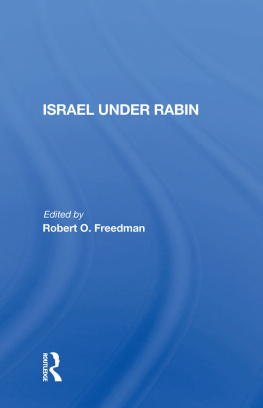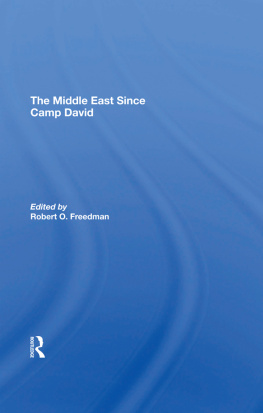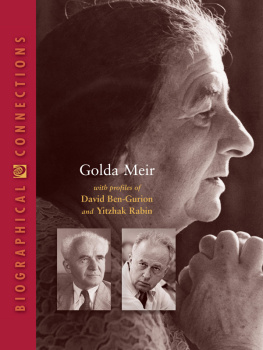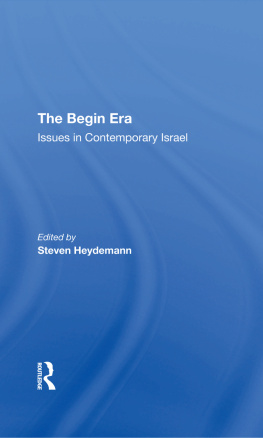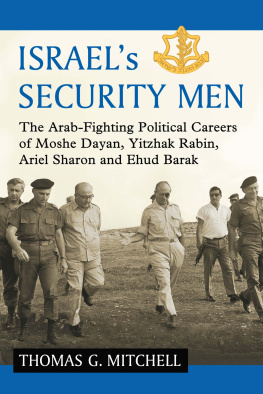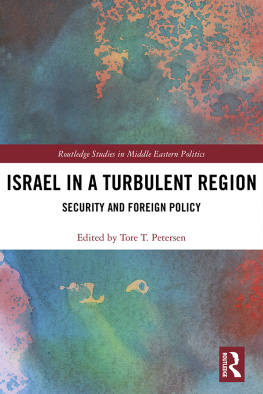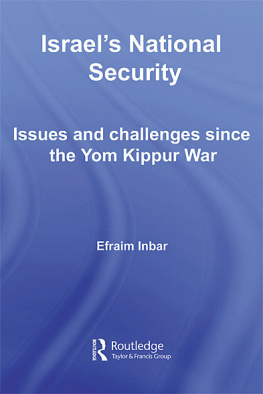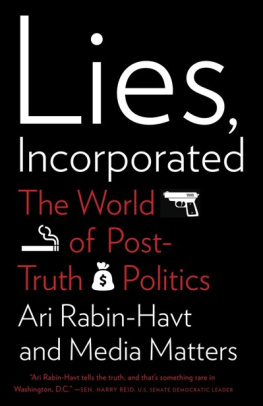First published 1995 by Westview Press, Inc.
Published 2018 by Routledge
52 Vanderbilt Avenue, New York, NY 10017
2 Park Square, Milton Park, Abingdon, Oxon OX14 4RN
Routledge is an imprint of the Taylor & Francis Group, an informa business
Copyright 1995 Taylor & Francis
All rights reserved. No part of this book may be reprinted or reproduced or utilised in any form or by any electronic, mechanical, or other means, now known or hereafter invented, including photocopying and recording, or in any information storage or retrieval system, without permission in writing from the publishers.
Notice:
Product or corporate names may be trademarks or registered trademarks, and are used only for identification and explanation without intent to infringe.
Library of Congress Cataloging-in-Publication Data
Israel under Rabin / [edited by] Robert O. Freedman.
p. cm.
Papers presented at a conference held in Nov. 1993 at Baltimore Hebrew University.
Includes bibliographical references and index.
ISBN 0-8133-2123-9. ISBN 0-8133-2124-7 (pbk.)
1. IsraelPolitics and governmentCongresses. 2. IsraelForeign relationsCongresses. 3. Rabin, Yitzhak, 1922- Congresses. 4. Jewish-Arab relations1973- Congresses. 5. Israel. Treaties, etc. Munazzamat al-Tahrir al-Filastiniyah. 1993 Sept. 13Congresses. I. Freedman, Robert Owen.
DS126.5.I835 1995
956.94dc20
94-31471
CIP
ISBN 13: 978-0-367-00959-5 (hbk)
To my mother-in-law, Jeanette Groginsky Center, and the memory of my father-in-law, Samuel Center
The Middle East has long been one of the most volatile regions on the globe. Wars, coups d'tat, rapid shifts in alliances and alignments, numerous intra-Arab, intrastate, and regional conflicts, and constant intervention by the superpowers have wracked the region since the first Arab-Israeli war in 1948. In an effort to increase public understanding of this complex region, the Center for the Study of Israel and the Contemporary Middle East of Baltimore Hebrew University was founded in 1977 and has held a series of conferences bringing together Middle Eastern specialists from various perspectives to analyze and discuss the region.
The first conference, held in 1978, examined the impact of the Arab-Israeli conflict on the Middle East, and the papers were later published as World Politics and the Arab-Israeli Conflict, edited by Robert O. Freedman (1979). The second conference, held in 1979 (two years into the administration of Israeli Prime Minister Menachem Begin), made a preliminary analysis of the dynamics of the Begin regime. Following the Israeli election of 1981, the papers were updated and published as Israel in the Begin Era, edited by Robert O. Freedman (1982). The third conference, which took place in 1982, dealt with Middle Eastern developments in the period between the Camp David Agreements of 1978 and the Israeli invasion of Lebanon in 1982. These papers were published as The Middle East Since Camp David, edited by Robert O. Freedman (1984). Just as the Camp David agreements marked a major turning point in the Middle East, so too did the Israeli invasion of Lebanon. For that reason, a fourth conference was held at Baltimore Hebrew University three years after the invasion to analyze its impact on the Middle East. The papers were published as The Middle East After the Israeli Invasion of Lebanon, edited by Robert O. Freedman (1986). The Iran-Contra affair was yet another key event in Middle East politics with major ramifications throughout the region, and a fifth conference was held at Baltimore Hebrew University in 1988 to assess the impact of the affair on the course of Middle East history. The conference papers were published as The Middle East from the Iran-Contra Affair to the Intifada, edited by Robert O. Freedman (1991). In December 1989, with the Intifada (Palestinian uprising) entering its third year, a conference was held to analyze its impact. The papers presented at that conference were published as The Intifada: Its Impact on Israel, the Arab World, and the Superpowers, edited by Robert O. Freedman (1991). The Iraqi invasion of Kuwait, which took place in August 1990, was another seminal event in Middle Eastern affairs, and fifteen months after the invasion, in November 1991, with the Madrid Arab-Israeli peace talks having just begun, a conference was held at Baltimore Hebrew University to assess the impact of the Iraqi invasion and the Gulf War, which followed it. The conference papers were published as The Middle East After Iraq's Invasion of Kuwait, edited by Robert O. Freedman (1993).
The return of the Labor party to power in Israel as the result of the June 1992 election was another major turning point in Middle Eastern politics. Unlike the Likud-led government of Yitzhak Shamir that preceded it, the Labor-led government, under the leadership of Yitzhak Rabin (who had served an earlier term as prime minister, from 1974 to 1977), appeared genuinely interested in a Middle East peace settlement, albeit one that would not threaten Israeli security. The first fruits of Israel's readiness for peace were contained in the Israeli-Palestinian Declaration of Principles of September 13,1993. In November 1993, a conference was held at Baltimore Hebrew University to assess the main foreign and domestic political developments that have occurred as a result of Labor's return to power in Israel. This book, the eighth in our series on the Middle East, is the outgrowth of that conference.
Many individuals and institutions should be thanked for their help in making possible both the conference and the book that emerged from it. First and foremost, generous grants from the Jack Pearlstone Institute for Living Judaism and Baltimore Hebrew University provided the bulk of the financial support for the conference. Second, I would like to thank the Israeli consul for academic affairs in the United States, Efraim Ben-Matityahu, for helping to defray the travel expenses of the Israeli participants in the conference. Third, I would like to thank Dr. Ian Lustick, president of the Association for Israel Studies, which served as cosponsor of the conference. Fourth, I would like to thank Dr. Norma Fields Furst, president of Baltimore Hebrew University, for her continuing strong support for the Center for Israel and the Contemporary Middle East. Fifth, the director of Baltimore Hebrew University's library, Arthur Lesley, and his staff assistant, Jeanette Katcoff, provided special assistance in expediting publication of the book, as did Yelena Feldman, my administrative assistant, who has helped to maintain the center's research files on the Middle East. And last, I owe special thanks to my secretary, Elise Baron, who typed the manuscript while also maintaining the Graduate Office of Baltimore Hebrew University in an exemplary manner.
Finally, a word about the transliteration system used in this book. Every editor dealing with a Middle East topic must decide between using the exact transliteration of Arabic names, including the initial hamza, or using a system that reflects the more common Western transliteration. To aid those readers who do not know Arabic, we have chosen the latter system, which renders the names of Arab leaders and places in a form that English-speaking audiences will recognize. Thus, for example, the reader will find Gamal Nasser (instead of Abd-al-Nasir), Hafiz Assad for Hafiz al-Asad, Muammar Kaddafi for al-Qadhafi, and Jordan's king's name will appear as Hussein rather than Husayn.


